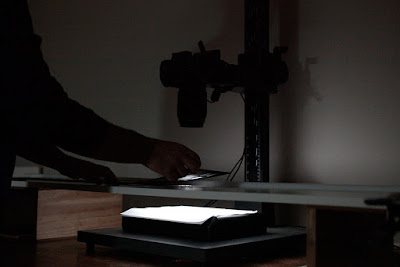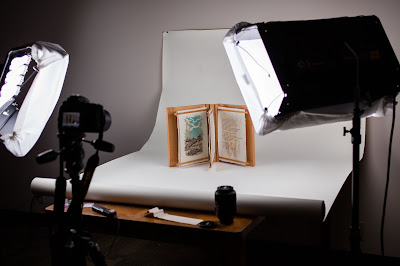The
Look Here!project is an experiment initiated by the UWM Libraries and aimed at
encouraging artists from the community and the UWM Peck School of the Arts to work
with and create art from our
digitized cultural heritage holdings –
archival materials, photographs, maps, prints, rare books and other objects.
Look Here! asks artists to propose projects that reimagine,
transform, and engage with these objects in ways that were unimagined before
the digital turn. The project will culminate in a panel discussion at UWM
Libraries in spring 2018, and an exhibit at
Villa Terrace Decorative Arts Museum in summer 2018.
Marc Tasman and
Clayton Haggarty are working together on a
piece for
Look Here! Theirs is the
first in a series of interviews with the artists participating in
Look Here!
What collections are you using or did you begin to use for your project?
We visited the archives shortly after the project began, and
then had a visit with Abbi Nye, Head of Archives, at the
DH Lab. We were really
taken by some of the images in the
online Polonia collection – the crash images
specifically.
How did what you found in the collections influence your work?
We agreed that those crash photos are captivating – seeing
the city the way it was and the crazy
situation of the wreck and its
documentation. It’s an opportunity to rubberneck, to slow down and see the
accident. But there are also the
wounded, battered people, who were also
probably in car accidents, because these images were taken/collected for
insurance purposes.
So we want to look at what it means to be wrecked, and then
to be documented. It’s also fairly personal – I don’t know if they are still
dressed from the accident or dressed up for the insurance photograph. But it’s
an airing of personal, intimate, vulnerable moments.
And then this ends up in an Archive where others can find
you years later.
The project is in part about society today and how civilized
or uncivilized we’ve become; we’re looking at issues of immigration and
acceptance and community. Part of what we’re interested in is the trauma of the
journey of the immigrant. In Oscar Handlin’s book, The Uprooted, he details how bad life must have been in the old
country to endure the really unpleasant voyage here; people taking advantage of
you, seasickness – we see it today with the Syrian refugees risking everything
to get here. And then they get here and have these new traumas happen.
We’d like to connect the experience to the neighborhood
itself, too. We went back to see the actual building and location where this
car crashed. It hasn’t really recovered – there is still some kind of wreckage,
coming undone there, even for the current occupants it seems. We’re also potentially interested in mapping
connections between the Polonia crash images and other parts of the city, and
institutions – to here at
RedLine, the UWM connection, to Villa Terrace. The
March on Milwaukee collection is another collection to potentially explore now,
given the marchers relationship to the south side, over the 16
th
Street Bridge, to Kosciusko Park (
note:
these are the neighborhoods documented in the Milwaukee Polonia collection).
How does having so much content available digitally affect the work you're
creating?
Having access to the digital image lowers the bar for
creating art with it – there are a lot of steps that are already taken. It’s an
interpretation thing, too – in this case, working with negatives. There is some
work of interpretation done already through the digitization process – it’s
like translation when it’s converted to positive digitally. It was an opaque
object before and you can’t read expressions as well in negative as positive.
Also, the crashes aren’t something we might have discovered
by going and searching through the boxes of glass plates. It’s not just that it
was easier, but it *is* about access – these insurance photos are not a form of
documentation we might otherwise have encountered or known we were interested
in. The documentation itself, that it occurred, allows us to access this. You
know, the invention of photography got a boost from the French government who
wanted to use it for mugshots, for surveillance – so another kind of archive;
another database to do with wreckage, incidents, and pummeled faces.
And now that we know there are insurance photographs – can
we track down the files, the insurance company? It raises new questions, or
possible paths.
And materially, these images are glass plate negatives, so
coming in off the street to see them could be a big deal. The entire collection
weighs 1.5 tons, we’re told. So I could only look at what I could carry. Using
both hands. It really wouldn’t have otherwise occurred to us to look at these
if they hadn’t been digitized.
It also deformalizes the relationship to the object and
takes away some of that preciousness. It’s easy to get the image, so the work
becomes locating the actual physical place where the event in the image took
place. Having the digital image encouraged industriousness because it meant we
could put the legwork elsewhere. We can feel free to remix the digital files
because it’s reproducible by its nature. Being digital has to encourage reuse
and transformation. It’s part of the nature of the digital medium.
The digital image is also not in the real world in the same
way that a monument (for example) is – it needs to be excavated in a different
way. We could have a more visceral reaction to the image and begin to create a
body of work that inhabits a physical space. The image provides evidence that
this thing really happened.
One question the digital raises for us as artists is, why
hasn’t a new form of art emerged from this? In the 60s and 70s the new thing
was experience – that the experience was the form of expression, and it was
tangible but ephemeral. We’re in a shift from the previous information epoch –
what are the new codes that will transform the way we make art? We’re in an age
of distraction – one image leads to another and another; what kind of discipline
does an artist need…?
And ultimately, when will creative media and art – work that
encourages remix – when will that stop being just an analogue of the old art –
rectangular, in a frame – and when will we truly transform that work the same
way the digital has transformed these cultural objects?
Our project is ultimately transformative – we’re converting
the digital to experience by bringing it into the Villa Terrace space, where
we’re also reusing and reimagining that space. And in it, looking at how things
have and haven’t changed over time. As artists, we’re still stuck to some
extent on this idea that art is objects, but we’ll get to that point where
artists will be curators of experience because we can’t keep making stuff.
That’s what digitization has taught us to do – we can let go of some of these
things. Not that we’re happy to give away all of our books or records. But
what’s meaningful isn’t the paper, it’s the experience. But that includes the
smells, the way you have to place the stylus on the record. So those kinds of
things are different. But with the wreck, we want to say, “look!” – these are
the things we cared about 20, 30, 80 and more years ago. These are familiar
concerns. Let’s not remake human civilization by not being empathetic, being callous
to the way people feel when you tear down buildings or push people out. So it’s
not anachronistic, because we can have that empathy across time. Is it really
out of place – that wrecked car in this beautiful mansion? It will be
interesting to work out how to make the piece so the wreck isn’t just jarring
and strange, but to say that we’ve all been in wrecks and we’ve all been
wrecked, so it’s a shared experience across time. We aren’t alone in being
alone.
======
Marc Tasman is an Intermedia artist focusing his research on the strength of social technologies to create meaning in culture. He is currently director of the Digital Arts and Culture Program and a Senior Lecturer in the Department of Journalism, Advertising, and Media Studies at the University of Wisconsin-Milwaukee. Tasman is also co-director of the Jewish Artists’ Lab, a consortium of six Midwestern cities founded in Milwaukee, and senior artist member of the residency program at RedLine Milwaukee. Tasman has screened work at the Ann Arbor Film Festival and published photographs in the
New York Times Digital Edition,
Huffington Post,
Mother Jones, and
Tablet Magazine. The first edition of his electronic, interactive book,
Internet Culture was published by Great River Learning press in 2017.
Clayton Haggarty is a Milwaukee-based interdisciplinary artist who earned his BFA in Painting and Drawing from the University of Wisconsin-Milwaukee in 2015. His work, which ranges from painting on canvas, to non-traditional forms of printmaking and public art, focuses on issues of social justice, climate change and the relationship between human beings and technology. Haggarty was the recipient of both the Laurence Rathsack Art Scholarship as well as the Elsa Ulbricht Memorial Scholarship for his work in the field of painting and drawing. His paintings have been included in multiple group exhibitions in the Milwaukee area at venues such as The UWM Union Art Gallery and Kenilworth Square East. Additionally, he briefly studied in Florence, Italy at the Santa Reparata International School for Art where his work was exhibited at the SRISA Gallery of Contemporary Art.
 For my project, I am using a work held in UWM's Special Collections entitled The Grammar of Ornament by Owen Jones published in 1856 and the AGSL Digital Map collections. By researching map images of the land boundaries of the areas and ornamentation covered in The Grammar of Ornament, I will be constructing new visual landscapes using the decorative ornaments from the book. The artist book will take a small sampling of ornaments from each of the 20 sections of the text and place them into a landscape created out of the reinterpreted boundaries of each country or region. This artist book will then be letterpress printed, hand-bound and editioned.
For my project, I am using a work held in UWM's Special Collections entitled The Grammar of Ornament by Owen Jones published in 1856 and the AGSL Digital Map collections. By researching map images of the land boundaries of the areas and ornamentation covered in The Grammar of Ornament, I will be constructing new visual landscapes using the decorative ornaments from the book. The artist book will take a small sampling of ornaments from each of the 20 sections of the text and place them into a landscape created out of the reinterpreted boundaries of each country or region. This artist book will then be letterpress printed, hand-bound and editioned.







